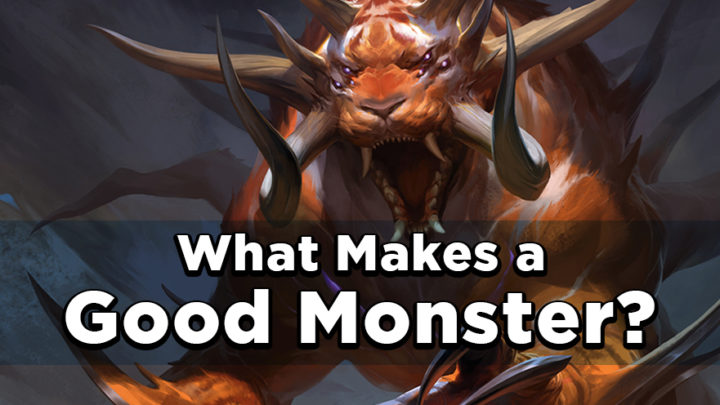Literally and figuratively, creatures are what give Magic life. The game was designed and balanced around the idea of playing creatures to attack and defend your life total, and that is how most people still learn to play it. As the main way for players to act on the game state other than casting spells, creatures are the natural stars of the show, offering players an emotional focus and visual identity for their deck. And the biggest creatures have always been the biggest stars!
The first generation of players latched onto the dramatic artwork and game-ending power of Serra Angel and Shivan Dragon — a pattern which was then repeated around other giant creatures for the best part of three decades. Wizards of the Coast recognized their popularity early on, admitting that they consider “Timmy/Tammy” — the stereotypical Magic player who just loves to cast huge bombs — to represent a large part of their audience. No set in recent memory has played to that audience like Ikoria: Lair of Behemoths, which uses new mechanics, art and even Godzilla himself to put huge monsters back in the spotlight.
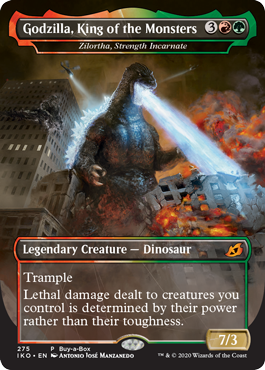
But that enthusiasm for oversized creatures has rarely been reflected in tournament Magic. Trying to fairly cast and attack with creatures over CMC four is simply not effective most of the time. While Wizards continues to design “Timmy/Tammy cards” in every set, that very definition exists to contrast them to cards made for “Spike” — the Magic player who prioritizes winning. Big, fun monsters have become a trap that serious players have to learn to avoid, along with lifegain and creature auras.
THEY DID THE MOOOOONSTER MATH
The first reason we don’t see more big creatures in tournament play is a simple matter of economy. Creature removal and counterspells in most formats cost one to three mana, and can trade for a creature of any size. If the next creature you play is likely to meet an opponent’s Swallow Whole, you would rather gamble three or four mana on it than six.
The second reason big expensive creatures tend to underwhelm is the demands of match tempo. Current Constructed formats are fast-paced and unforgiving, so most decks have to proactively advance their game plan on every turn. If your key creature costs three, you can reliably make your first three land drops to cast it on curve, even if you don’t start with them all in hand. It’s quick enough to reach in every game, and you can use your interaction on the first two turns to protect yourself or prepare the rest of your plan.
If your key creature costs six mana, though? You’re not just waiting until turn six to play that. At some point, you’ll run out of lands in hand, and you don’t automatically draw a land every turn. We’re talking turn eight, nine, even turn ten before you can find enough lands and deploy your bomb! That is a very long time to have to defend yourself, and you could end up critically far behind before you finally draw the sixth land. So any six-mana threat you want to play has to be able to single-handedly snatch victory from the brink of defeat — and very few creatures are good enough for that.
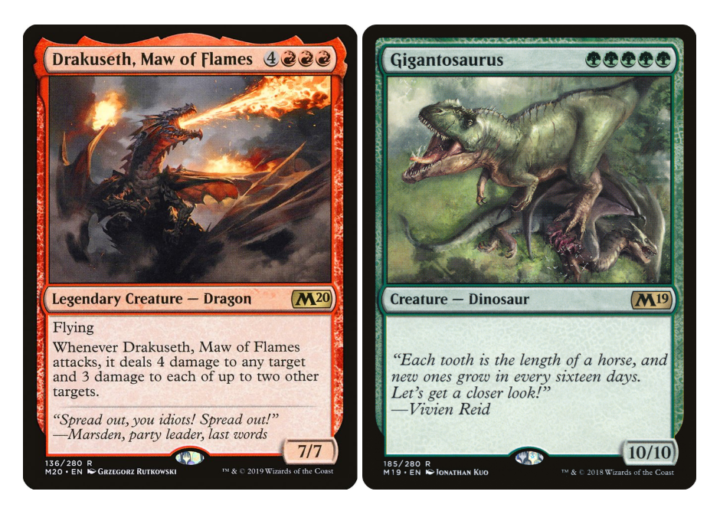
In the last few years, Wizards has begun to push the design of expensive creaturess a lot more, particularly in ways which skirt around improving those inherent drawbacks (like making them enormous!). But they have also significantly beefed up the power level of three-to-four mana threats, which has crowded out the need for bigger cards in most cases. Why waste cards ramping into a seven-mana monster when Questing Beast can get the job done? There’s no reason to increase your risk with a big, slow, expensive card when something medium-sized will still win the game.
How are the monster-makers of the Ikoria design team going to bring these beatsticks back into fashion?
APPROACH 1: RAISE THE FLOOR
The equation needs to change somehow in favor of these monstrosities, and the easiest way to do that is reduce the inherent risk of playing them. If a creature carries a powerful enters-the-battlefield effect or has haste, then players are able to guarantee getting some value by casting it when their opponent taps out. A “when you cast” trigger is more rare but even more guaranteed, and even a “when this dies” trigger helps you feel better about playing into possible removal.

This approach has already become extremely prominent as a way of pushing creatures all over the curve. Examples from current Standard include the Cavalier cycle, Skarrgan Hellkite, Hydroid Krasis and End-Raze Forerunners. The average number of ETB creatures per set has been rising steadily since Kaladesh; if you include the “whenever this mutates” variants, Ikoria has the highest count from that whole period, at 51.
There’s some valid discussion to be had over whether removing the inherent risk from so many cards is good for Magic, but it’s the lumbering hulks of Ikoria which need this treatment the most. Ikoria has also reintroduced one of the other ways to offset risk on expensive cards by bringing back cycling. “Alternate use” mechanics like cycling, adventure or evoke go further than guaranteed value triggers: they remove the deck-building risk, assuring you that your seven-mana Beanstalk Giant will never be stuck dead in hand. This goes a long way to making niche cards playable, and I would love to see more mechanics use this space.
Yidaro, Wandering Monster is a perfect encapsulation of these floor-raising design ideals. Not only does it effectively guarantee a damaging hit with trample and haste, but its unique cycling mechanic makes it feel more like a cantrip with a dinosaur turtle insurance policy attached. When you reduce the risk this much, slow decks have to start asking themselves what reasons they have not to play Yidaro, and I’ve already seen prominent deck-builders in the community reaching for this weirdly-hasty turtle.
APPROACH 2: REINFORCE THE CEILING
Removing the risk of failure from these cards makes them a lot more palatable, but it’s risky to adopt this kind of approach too widely. Why not try the opposite: improving the reward when a creature does stay on the table? It’s true that cards like Nissa and Questing Beast are usually good enough to win the game, but threats that close quickly, consistently and resiliently can tempt players into aiming a little higher.
These sorts of bombs are the ones that historically show up as finishers in control decks. Those strategies want the card that’s most likely to win the game by itself in any situation, regardless of cost. These creatures are usually recursive or hard to remove; they keep you alive through vigilance or lifelink, or simply by removing opposing creatures; they provide inevitability through evasive attacks or an actual alternate win condition. Dream Trawler is a prominent example, but underplayed threats like Feasting Troll King and Lochmere Serpent fall into this category as well.
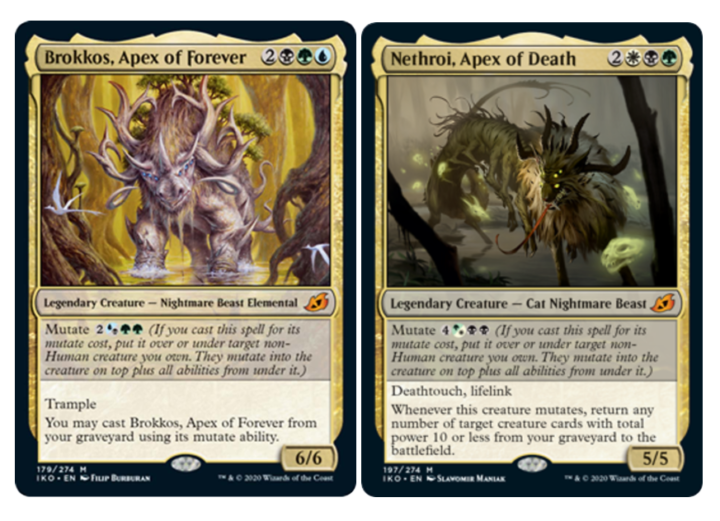
These two members of the Apex cycle are a nice cross-section of what you’re looking for in these ceiling-reinforced threats. While it’s possible to get blown out after paying five for Brokkos, it’s the kind of card you only look to play once the rest of your deck has established a position for you where that trade isn’t life-threatening. At that point, you can simply unleash an endless assault of Brokkos-mutated tramplers until your opponent crumbles. On the other hand, Nethroi does a great job of keeping you alive thanks to deathtouch and lifelink, buying time until you can reanimate your choice of infinite combo using its mutate trigger! These cards are a little slow and expensive, but the payoff goes a step beyond what you would get from just an efficiently-statted threat and justifies the effort of building to support them.
APPROACH 3: LIMIT ACCESS
This might sound a little odd, but the other easy way to give big creature designs a lift is to make them even harder to play!
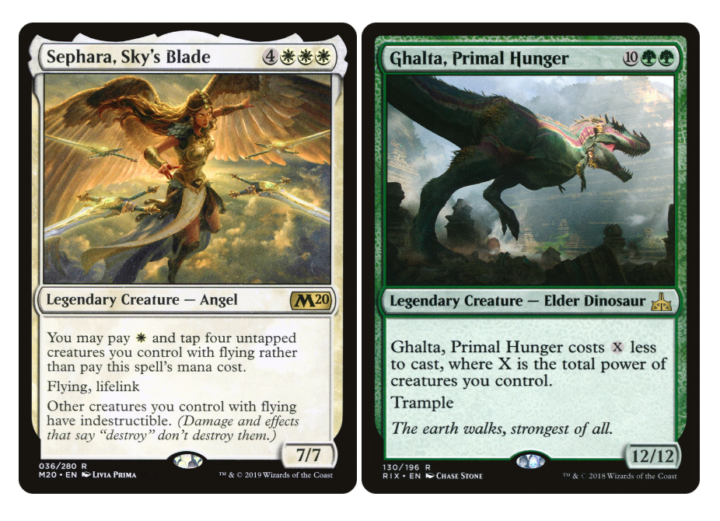
Currently, Standard is overrun by ramp and midrange decks that ramp into a stream of the best haymaker threats. These “goodstuff” decks make the high-cost creatures more playable because they are able to play them sooner, and because their density of powerful cards means they don’t need any one threat to dig them out of a hole or win the game outright. If you spend your turn dealing with the threat, they’ll have another bomb ready next turn, and the next turn, until you eventually run out of answers.
This creates balance issues because any huge monster that’s good enough to play in other decks is usually better in “goodstuff”; Hydroid Krasis and Nissa, Who Shakes the World are the key examples currently. By adding more specific hoops a deck-builder has to jump through to cast or get value from a bomb, designers are then free to raise the power level on that creature significantly, knowing it won’t become part of an ultra-consistent “goodstuff” shell.
You can see this style of design in Niv-Mizzet Reborn, Korvold, Fae-Cursed King, and Vantress Gargoyle, as well as many classic threats like Thing in the Ice, Death’s Shadow, and all the Theros and Amonkhet gods. But it’s the Eldrazi, with their strict colorless mana requirements, tribal lands and all-time-high power level, who are probably the best example in Magic’s history.
HAVING A PET DECK PAYS OFF
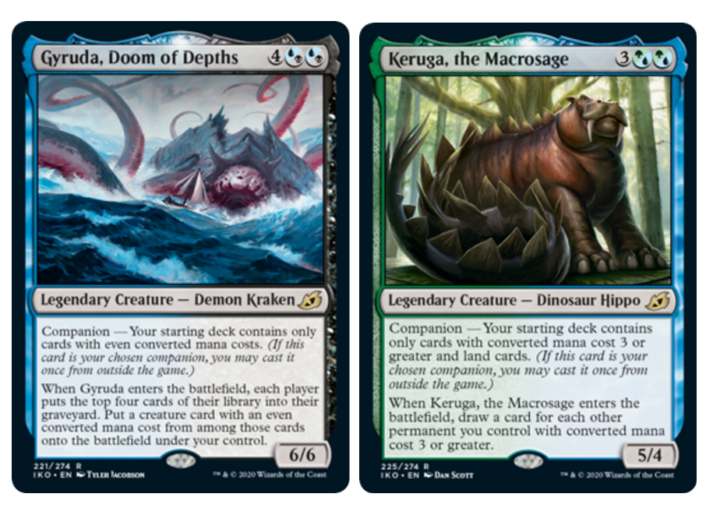
Gyruda and Keruga also fit the bill of “expensive bomb,” but all of the new and controversial companion creatures depend on this limited access principle to justify their unique power. Starting the game with a guaranteed extra card in hand is a huge reward for a little deck-building finesse, and early forecasts for these (mostly) cute pets have them as prospective staples across every Constructed format. If they manage to remain legal (sorry, Lutri!), then these might embolden Wizards to create a new breed of build-around beasties we can enjoy.
You can watch me put the many massive monsters of Ikoria through their paces in the MTGA set preview event this week, where I’ll be pulling my usual non-stop brewing marathon on a WotC-sponsored VIP account. Catch me starting at 8AM PDT on twitch.tv/thewanderingbard!

Tom’s fate was sealed in 7th grade when his friend lent him a pile of commons to play Magic. He quickly picked up Boros and Orzhov decks in Ravnica block and has remained a staunch white magician ever since. A fan of all Constructed formats, he enjoys studying the history of the tournament meta. He specializes in midrange decks, especially Death & Taxes and Martyr Proc. One day, he swears he will win an MCQ with Evershrike. Ask him how at @AWanderingBard, or watch him stream Magic at twitch.tv/TheWanderingBard.

